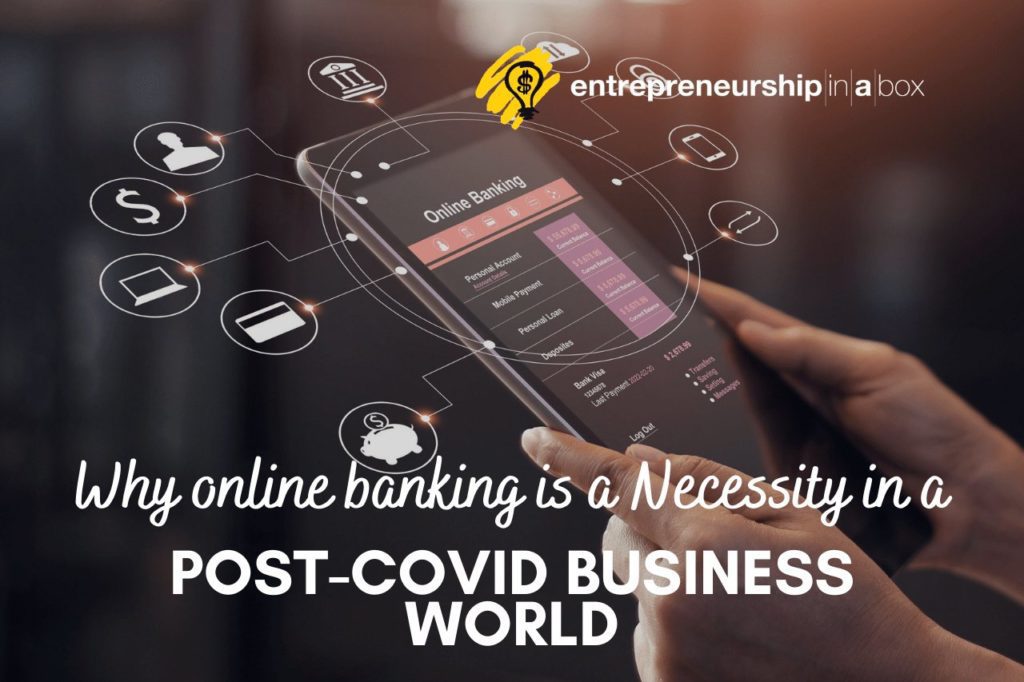The banking industry is shifting perspectives and practices in the wake of the global pandemic. Facing nationwide branch closures and a massive increase in digital spending, small-to-medium businesses (SMBs) and enterprise banking customers are finding online banking to be a necessity in a post-COVID business world.
In This Article:
- The Rise of Online Banking
- How Businesses Benefit from Online Banking
- Contactless Payments
- Merchant Accounts
- Online Lenders and Small Businesses
- FinTech Companies and Small Businesses
- Can Branch-Based Business Banking be Avoided?
- Is the Future Cashless?
The Rise of Online Banking
Online banking dates back to the mid-1990s when the first banks to offer remote banking options started allowing customers to check their balances via SMS texts. By 1999, PayPal had established itself as one of the first “bank challengers,” enabling small business owners and independent contractors to receive payments online.
Banks have slowly moved services online over the intervening two decades. Banking customers (both individuals and businesses) can receive statements digitally, check balances online, make transfers remotely, and apply for loans without visiting a branch.
Quite a few completely online banks, sometimes called neobanks, have also emerged, existing without a physical location or branches. The appearance of COVID-19 in early 2020, with its quarantines and lockdowns that radically changed consumer behavior, also hastened the shift in the banking industry toward increasing digital services.
The digital-only banks offer banking services virtually via an app or a browser interface. For new business owners, online business banking is proving to be both flexible and cost-effective.
The best online banks tested and ranked provide support both for individual account holders and businesses seeking the top banking options available.
Businesses Benefits of Online Banking
While consumers have been quick to embrace online banking, many established businesses were slower to adopt digitized options. That is changing because of the need for social distancing, which has made online banking more attractive. In a post-COVID world, habits created during the time of physical bank closures are likely to stick.
New Business Accounts
Entrepreneurs starting a new venture need a business banking account. With branch closures and minimized lobby hours, finding a location to open a bank account became problematic. Online options have allowed new business owners to open accounts virtually.
Online banking saves business owners time by enabling them to perform many functions remotely. Users can deposit checks digitally, look at transactions, and make transfers—all without visiting a physical branch. Waiting in line for a cashier is becoming a thing of the past.
Online Payments
CFOs can initiate deposits or payments to and from their online business account via their laptops or smartphones. Automatic Clearing House (ACH) payments can be processed overnight to pay vendors or complete payrolls. Wire transfers initiated online will take care of urgent expenses and one-time purchases.
Online business banking can also streamline the payment of business-related expenses. Automated processes ensure that recurring bills never have a late or missed payment. Avoid late fees by arranging for digital payments instead of mailed checks.
Streamlined Accounting
Balancing the books is simple for businesses with online bank accounts. Information from bank records interfaces readily with accounting software to simplify bookkeeping.
Small business owners can give specific employees limited access to online business banking accounts. Accountants can view statements without being permitted to initiate transactions. Department managers can initiate payment transactions to vendors that then require a C-suite executive’s approval before they go through.
Account Monitoring
Businesses with vast numbers of transactions each day may find it challenging to track down a specific item in response to a customer query. With online banking, multiple filters and real-time updates make transaction searches easier.
Online systems provide fraud-prevention support that can help flag potentially problematic transactions. This benefit makes it easier to maintain a good business reputation. Data-driven algorithms can spot variances in sales patterns, identify possible fraud cases, and prompt business owners to act.
Mobilized Business Banking
On-the-go business owners don’t always have time to visit the bank branch or even return to their office to log in to their online accounts. Mobile business banking allows access via a smartphone or tablet, which many business owners have found to be a versatile lifeline. Full online functionality on mobile devices now enables them to fulfill banking needs anywhere and at any time.

Low or Eliminated Fees
With online banking options has come the reduction or elimination of any fees associated with business banking. A free business debit card is standard fare with many online banking options. Fees for maintaining a minimum deposit are rare, giving way to incentives for carrying a balance such as attractive interest options.
Contactless Payments
With a coin shortage spurring many businesses to institute “no-cash” policies, and many stores closing physical locations completely to sell online, payment digitization is a priority for many companies.
Contactless spending and online retail purchases drastically changed business revenue flow in the first quarter of 2020. This newfound familiarity with online shopping, coupled with its convenience, may mean that the shift will be permanent. Businesses are finding the need to adapt by making it easy for consumers to spend at their location rather than shop a competitor.
Users can now swipe through, slot into, or tap credit and debit cards against a reader for fast, easy payment. In some cases, smartphones can instantly transmit saved card information. Visa saw contactless use spike by 150% in the days following the COVID-19 outbreak, and half of Mastercard users now prefer contactless payments.
Merchant Accounts
Overall, since March 1, e-commerce spending amounts to nearly $78 billion more than anticipated. Businesses that accept credit cards see more revenue than cash-and-carry stores, but waiting for payments to clear can cause unacceptable cash flow issues. Having a merchant account streamlines the process.
An online bank that offers business accounts can typically supply a merchant account as well. Merchant accounts have an underwriting process based on factors like credit history and company size. Once approved, small business owners can benefit from rapid payment clearance.
Online Lenders and Small Businesses
Online loan applications are supplanting in-bank application processes. Traditional banks can take weeks to approve a business loan application and months to fund an approved loan. Digital loan applications can cut the “time to yes” down to mere minutes, and “Time to get cash” to a business day or less.
In 2018, more than 50% of loan applicants used online processes for part or all of the loan process. By 2019, that number had climbed to 65% of applicants, and by the end of 2020, that percentage will undoubtedly increase dramatically.
The pandemic revealed a new purpose for online lenders. The U.S. Small Business Administration (SBA) Paycheck Protection Program (PPP) aimed to help small-and-medium businesses (SMBs) weather the pandemic. The program provided for 100% forgivable loans when used for payroll costs.
Unfortunately for many SMBs, traditional banks typically favor servicing a few large loans over many small ones. The documentation and compliance involved in processing small business loans meant that big banks opted to disburse funding in larger chunks. In June 2020, the average PPP loan amount funded was $107,000.
SMBs seeking smaller loan amounts of $25,000 or less found better luck online. The online lender Kabbage received the second-most PPP applications of any lender (coming in just under banking behemoth Bank of America). The average Kabbage loan was around $23,000, with 50% of loans amounting to less than $13,000 each.
FinTech Companies and Small Businesses
Financial technology companies (FinTechs) are making progress in their efforts to obtain official bank charters. They can provide both individuals and businesses with streamlined accounts and lending options.
PayPal and Amazon are both top-five small business lenders. The base loan approvals on applicant history on their platforms instead of using traditional credit-worthiness methods. Small businesses can benefit from these online platforms to scale without depending on conventional banking.
Can Branch-Based Business Banking be Avoided?
The two primary reasons banking customers visit a branch is to initiate a transaction requiring in-person identity verification or to make a payment for which there is no online option. Businesses also have another reason for visiting a branch: making cash deposits.
Many ATMs now accept some, but not all, cash deposits. Not every machine has the functionality to count bills in real-time, and ATMs may reject older or damaged currency. ATMs that allow closed-envelope-based deposits often incur a delay in fund availability.
Banking methods will need to transform even more to overcome these obstacles. New, improved ways of remotely proving identity must first be tested and accepted. Banks must further embrace online functionality to make all previous “branch-only” activities available online.
As far as reducing the need for business owners or employees to make repeated trips to a branch to deposit cash, the shift still further toward a cashless society is critical. Banks will need to pioneer and support initiatives to help cash-based businesses switch their customer base to digital payments.
Cash-heavy businesses can reduce or eliminate cash deposits by providing branded debit cards to their clientele. The branded card might be purchased either onsite or online with a debit or credit card and then recharged as needed. Services or purchases will debit directly against the balance on the card, relieving the need for cash payments.
Is the Future Cashless?
Nearly one-third of consumers in a recent survey stated they would like to see paper money and coins phased out entirely in the future. Financial institutions must find ways to service the unbanked and underbanked to make a cashless society a reality. Bank challengers and FinTechs are stepping in to fill the needs of those who cannot access traditional bank accounts.
It’s not likely that currency will fully digitize anytime soon, but support for the concept is growing. This trend adds one more reason to why online banking is a necessity in a post-COVID business world.

Author
Chris Muller
Chris Muller is a professional personal finance writer who has written for some of the largest financial publications in the world. Chris brings a BBA and MBA in Finance, along with a decade of experience in the field, to help break down complex financial topics into easily digestible pieces through his written content to assist others in better managing their finances. Chris is currently in pursuit of FI/RE, is an aspiring minimalist, loves craft beer, and is a dad to two kids.



